Best laptops for video editing 2023: Best overall, best screen, and more
Video editing can put a heavy burden on any computer. So, when shopping for a laptop for video editing, you’ll want to make sure you’re loading up with some heavy hardware firepower. While you might not need the absolute top of the line gear, simply buying a gaming laptop and calling it a day is probably not going to cut it. Serious video editors need to take into account a few things, including processor and graphics performance, the quality of the display, port selection, and other factors.
We’ve tested countless notebooks in our never-ending quest to find the best laptops. And through this we’ve developed a comprehensive view of the laptop landscape. This has allowed us to identify laptops that fit specific needs, such as video editing. We’ve taken note of the best laptops for video editing and curated a list to help you. Take a look at our top picks below, followed by buying advice and information on how we test our laptops for video editing purposes.
If you’re on a budget or just looking to save some money, you may also want to check out our daily roundup of the best laptop deals to scope out any discounts on content creation notebooks.
1. Dell XPS 17 (2022) – Best laptop for video editing
Pros
- Solid performance for the price
- Massive, bright, colorful display
- Offers four Thunderbolt 4 ports
- Long battery life
Cons
- Heavy and thick
- Mediocre keyboard
- Lacks USB-A, HDMI, or Ethernet
- RTX 3060 is the quickest available GPU
We consider the Dell XPS 17 the ultimate content creation laptop, so it’s no surprise to see this atop our list of the best laptops for video editing. The Intel 12th-gen Core i7-12700H processor and Nvidia GeForce RTX 3060 inside deliver plenty of punch for intense edits, while a 1TB SSD delivers top-notch storage performance for moving big projects around.
The XPS 17 also includes crucial extras coveted by video editors, such as an SD card reader, Thunderbolt 4 ports aplenty, and a luscious 17-inch touchscreen panel with 3840×2400 resolution, and a more productive 16:10 aspect ratio. Dell even managed to cram all these niceties into a relatively portable-for-its-class 5.34-pound design that can run for 11 hours before needing a charge—improving upon the previous XPS 17 version by over one hour.
Read our full
Review Dell XPS 17 (2022)
2. Dell XPS 15 9520 – Best screen for video editing
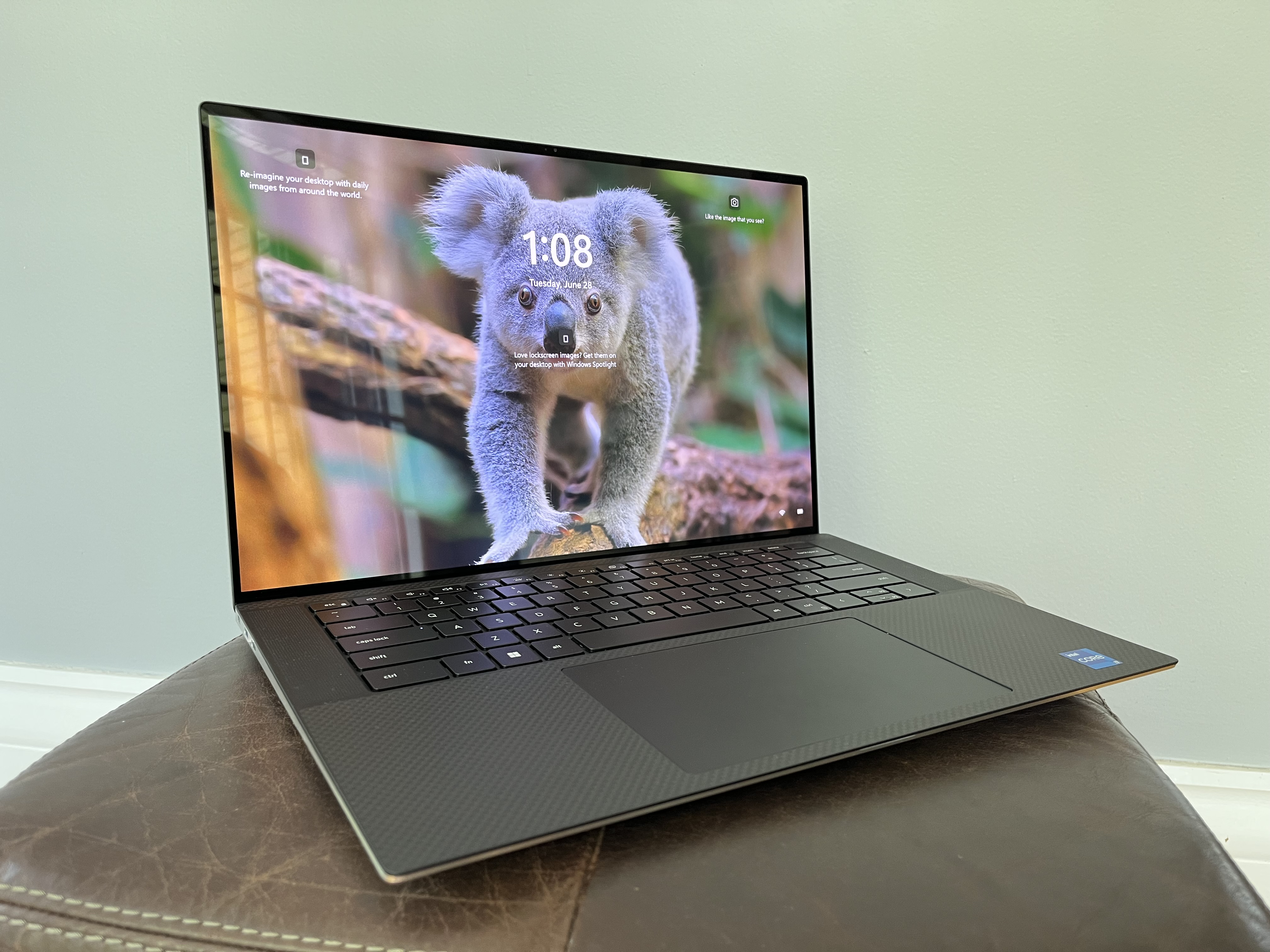
Pros
- Stellar OLED display
- Chassis is rugged and gorgeous
- Booming audio
- Roomy keyboard and touchpad
Cons
- 15.6 < 16 inches
- Underwhelming battery life
- Webcam is behind the times
- Limited ports
The Dell XPS 15 9520 has a stunning OLED display and with its latest Intel Core i7-12700H CPU and GeForce RTX 3050 Ti graphics, it has become one of our favorites for content creators and video editors. To add to an already impressive system, the rugged and beautiful all-metal enclosure is just the cherry on the top of a premium-quality cake.
Despite it being a 15-inch laptop, it is a bit heavy to carry on an everyday commute, and it lacks some of the ports that come with the XPS 17 model. But the gorgeous OLED display is the star of the show, and it doesn’t let you down with a 3456X2160 resolution, 16:10 aspect ratio, and ultra vivid and accurate colors.
Read our full
Review Dell XPS 15 9520
3. Asus Zenbook Pro 14 Duo OLED – Best dual-monitor option
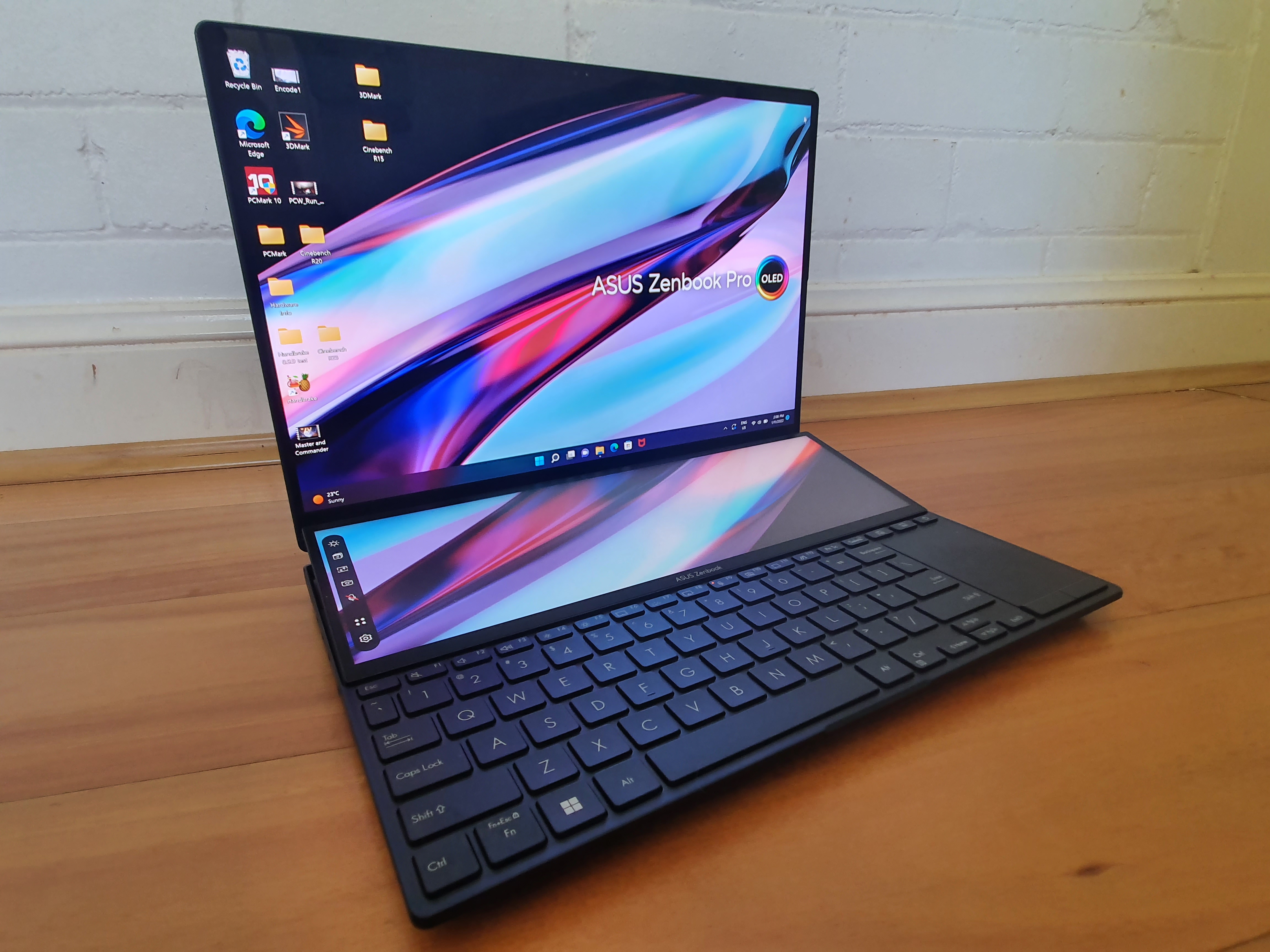
Pros
- Stunning primary display and easy to see secondary display
- Excellent I/O options and wireless connectivity
- CPU / GPU power meets the needs of content creators
Cons
- The battery life is lacking for a productivity laptop
- The trackpad is small and awkwardly placed
- Rear orientated ports can be hard to reach
Now for something a bit different. The Asus Zenbook Pro 14 packs decent firepower, including a Core i7 processor, GeForce RTX 3050 graphics, 16GB of DDR5 memory, and a fast 1TB NVMe SSD. It also has a 14.5-inch 4K touch OLED panel that dazzles at an ultra-bright 547 nits while covering 100 percent of the DCI-P3 color gamut—a screen built for serious content creators. But the truly interesting part is the secondary 12.7-inch 2880×864 screen located just above the keyboard. Windows counts it as a second monitor and you can use bundled Asus software to put it to all kinds of helpful tasks, such as using it as a trackpad or displaying a panel of touch controls for certain Adobe apps.
The Zenbook Pro 14 Duo OLED is basically a portable midrange workstation, though the mediocre battery life may mean you’ll need to carry around a charging cable if you need to do some serious work. Despite this, the Zenbook Pro 14 Duo OLED is a well-tuned machine for content creators, excelling at tasks such as 3D rendering and encoding and this latest version of Asus’ dual screen is the best yet.
Read our full
Review Asus Zenbook Pro 14 Duo OLED
4. Razer Blade 14 (2021) – Best ultra-portable laptop for video editing
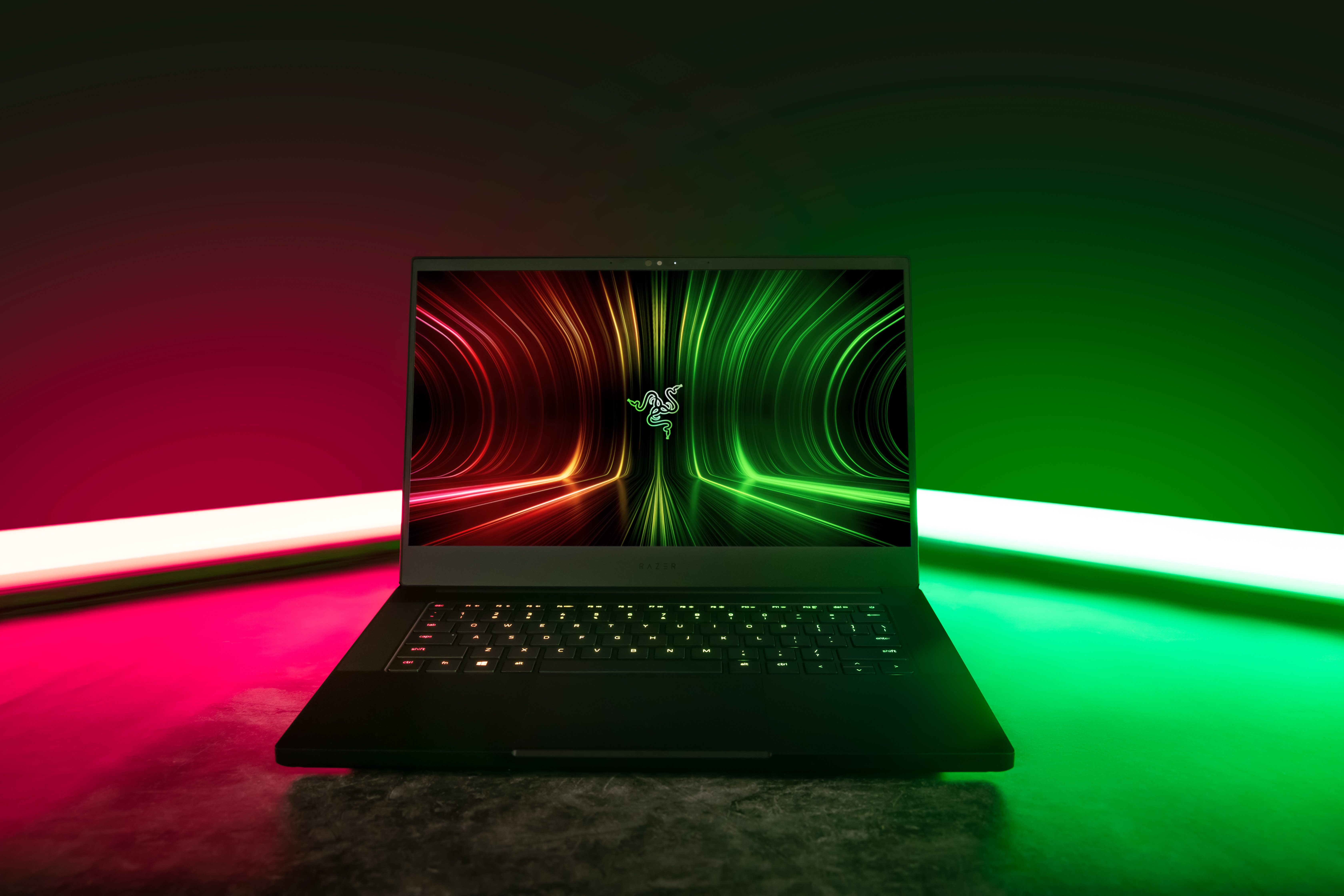
Pros
- It performs capably in AAA games
- The QHD panel looks great
- It’s exceptionally quiet
Cons
- AC adapter is heavy at 1.7 pounds
- Razer products are pricey
- No Thunderbolt 4 support
If pure portability is essential, consider the Razer Blade 14. This ultra-thin laptop measures just 0.66-inch thick and tips the scales at a mere 3.9 pounds, making it significantly smaller than most laptops with video editing chops. But Razer didn’t skimp on the firepower, loading the Blade 14 with AMD’s 8-core Ryzen 9 5900HX flagship CPU, Nvidia’s 8GB GeForce RTX 3080, a 1TB NVMe SSD, and 16GB of memory.
You’ll give up some perks in exchange for the Blade’s portability though: The 14-inch IPS-grade screen comes factory calibrated, but tops out at 2560×1440 resolution. 4K video editing is off the table, though the laptop supports the full DCI-P3 color gamut. Razer’s notebook also lacks an SD card slot. But if you need a fierce rig that can chew through edits and renders then slip easily into your bag, the Blade 14 is worth considering.
Read our full
Review Razer Blade 14 (2021)
5. Dell Inspiron 16 – Best laptop for battery life

Pros
- Roomy 16-inch 16:10 display
- Long battery life
- Competitive application performance
- Comfortable keyboard and huge touchpad
- Quad speakers pump up the jams
Cons
- Lone GPU upgrade is lackluster
- Can’t go bigger than 512GB SSD
- Large screen can feel awkward in tablet mode
If it’s battery life that you’re concerned about, the Dell Inspiron 16 should cover you just fine. When we ran our battery benchmark, which cycles through a series of tasks and videos until the laptop dies, the Inspiron 16 lasted a marathon 16.5 hours on a single charge. That should allow you to edit to your heart’s content while out on the road. Due to the battery, it isn’t the most portable, however, weighing in at a substantial 4.7 pounds.
It’s rather inexpensive, but for the price you will have to make sacrifices. It sports a Intel Core i7-1260P CPU, Intel Iris Xe graphics, 16GB of RAM, and 512GB of SSD storage. While that should get the job done with most video-editing projects, it does lack storage capacity, so you will need an external drive if your saving video files. What really makes this laptop shine though, is the outstanding battery life which is an often overlooked aspect of mobile video editors. And as a bonus perk, it also comes with a surprisingly robust quad speaker system. For ports, you’re getting two USB Type-C, one USB-A 3.2 Gen 1, one HDMI, one SD card reader, and one 3.5mm audio jack.
Read our full
Review Dell Inspiron 16 2-in-1
6. MSI GE76 Raider – Best gaming laptop for video editing
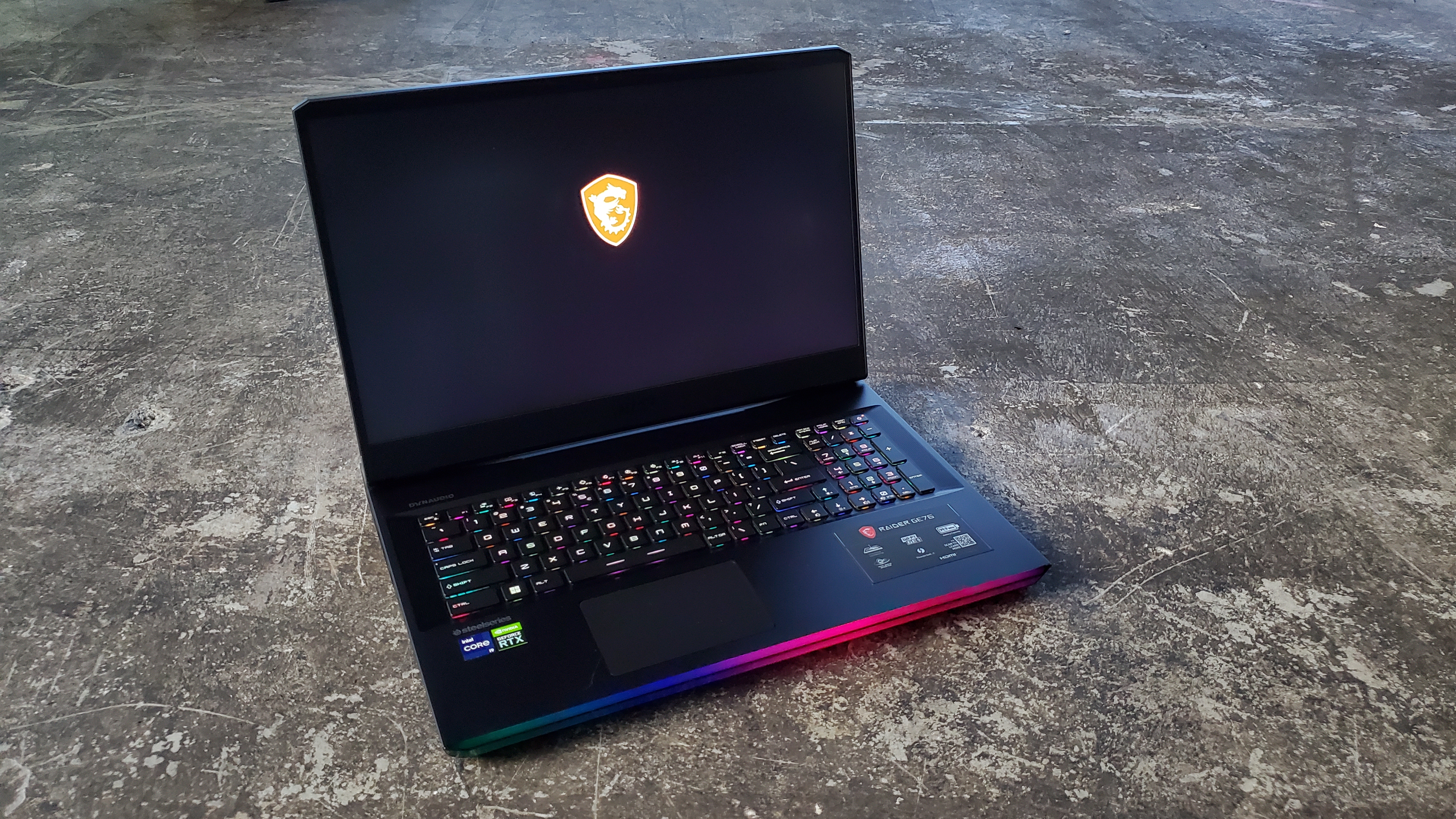
Pros
- 12th-gen Core i9-12900HK simply sings
- New “AI” performance mode greatly moderates fan noise.
- 1080p webcam and good mic and audio makes for decent video conferencing PC
Cons
- Third iteration in the same body
- MSI Center is confusing and cluttered UI
- Painful pricing
MSRP:
$4,200 (Core i9, RTX 3080 Ti)
If you’re looking for the most raw firepower possible, on the other hand, nothing burns through video edits faster than a big, heavy gaming laptop. The MSI GE76 Raider chewed through the Adobe Premiere test in UL’s Procyon benchmark faster than any other notebook thanks to its burly 14-core Intel Core i9-12900HK chip, an Nvidia RTX 3080 Ti tuned for a blistering 175 watts, and ample interior cooling. It even has an SD Express card reader hooked into the PCIe bus for high-speed card transfers. One downside to using last year’s model was its gamer-focused 360Hz 1080p display, but the higher-end version of this year’s 12UHS added a 4K, 120Hz panel that, while not tuned for content creation, should satisfy video editors much more, especially with its spacious 17.3-inch screen size. You sure pay for all that firepower, though.
Read our full
Review GE76 Raider 12UHS
7. HP Envy 14 14t-eb000 (2021) – Best budget laptop for video editing
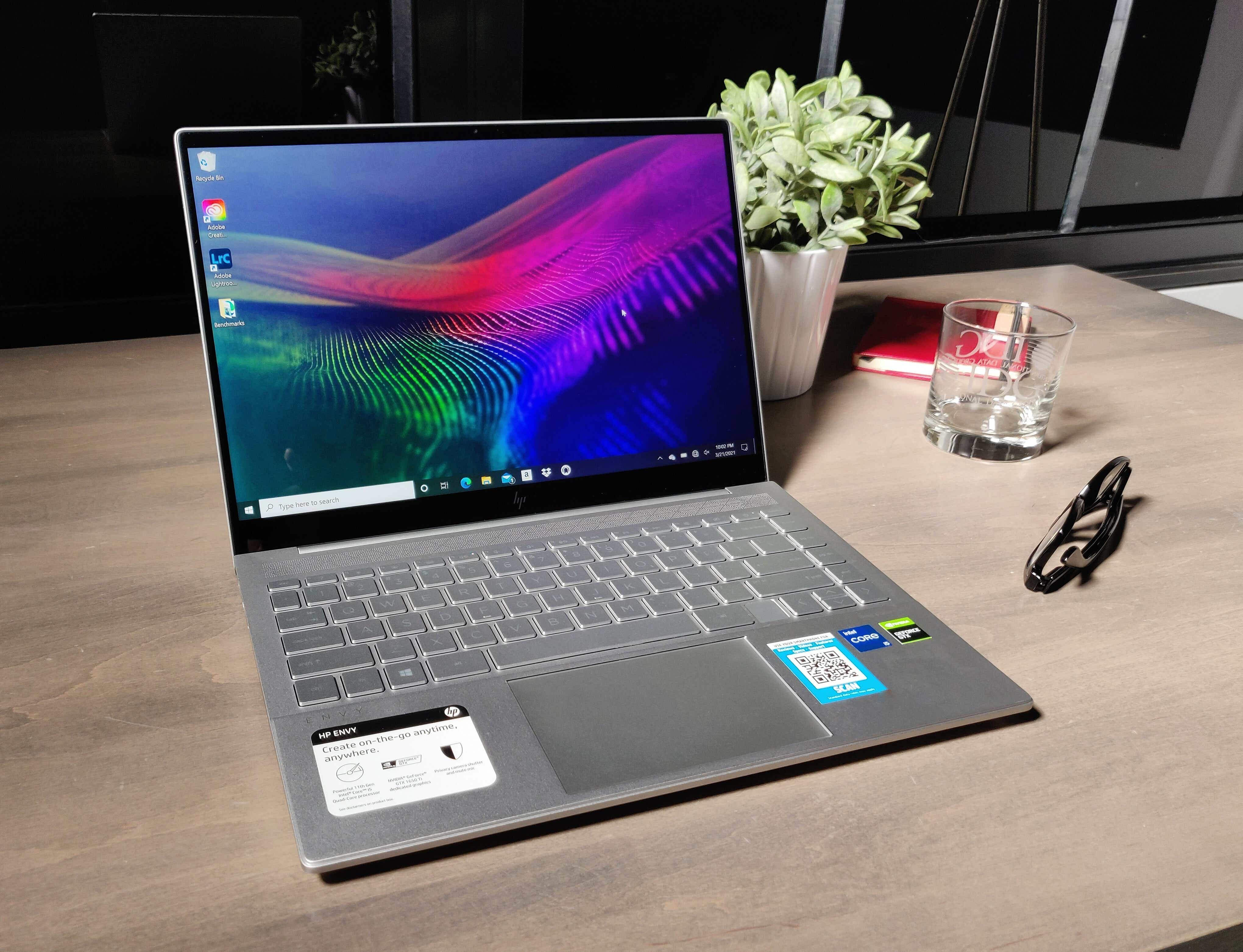
Pros
- Good value for the money
- Fantastic battery life
- Quiet fan, with no detectable performance throttling
- Thunderbolt 4 support
Cons
- Slightly quirky keyboard layout
- Webcam’s signature feature is ineffective
You’ll need to spend up for heftier hardware if you want the fastest possible video edits and renders, but not everyone can afford to. If you want a solid, basic content creation laptop that won’t break the bank, check out the HP Envy 14. The entry-level GeForce GTX 1650 Ti GPU and Core i5-1135G7 processor aren’t barnburners, but they’ll get the job done, and at roughly $1,000 the price is certainly right. The 14-inch 1900×1200 display features a 16:10 aspect ratio for improved productivity, along with factory color calibration and 100-percent sRGB support (though not DCI-P3). Better yet, the HP Envy 14 includes crucial SD card and Thunderbolt ports, and it runs surprisingly quiet too.
Read our full
Review HP Envy 14 14t-eb000 (2021)
8. Asus ROG Zephyrus S17 – Another gaming laptop that’s great for content creation
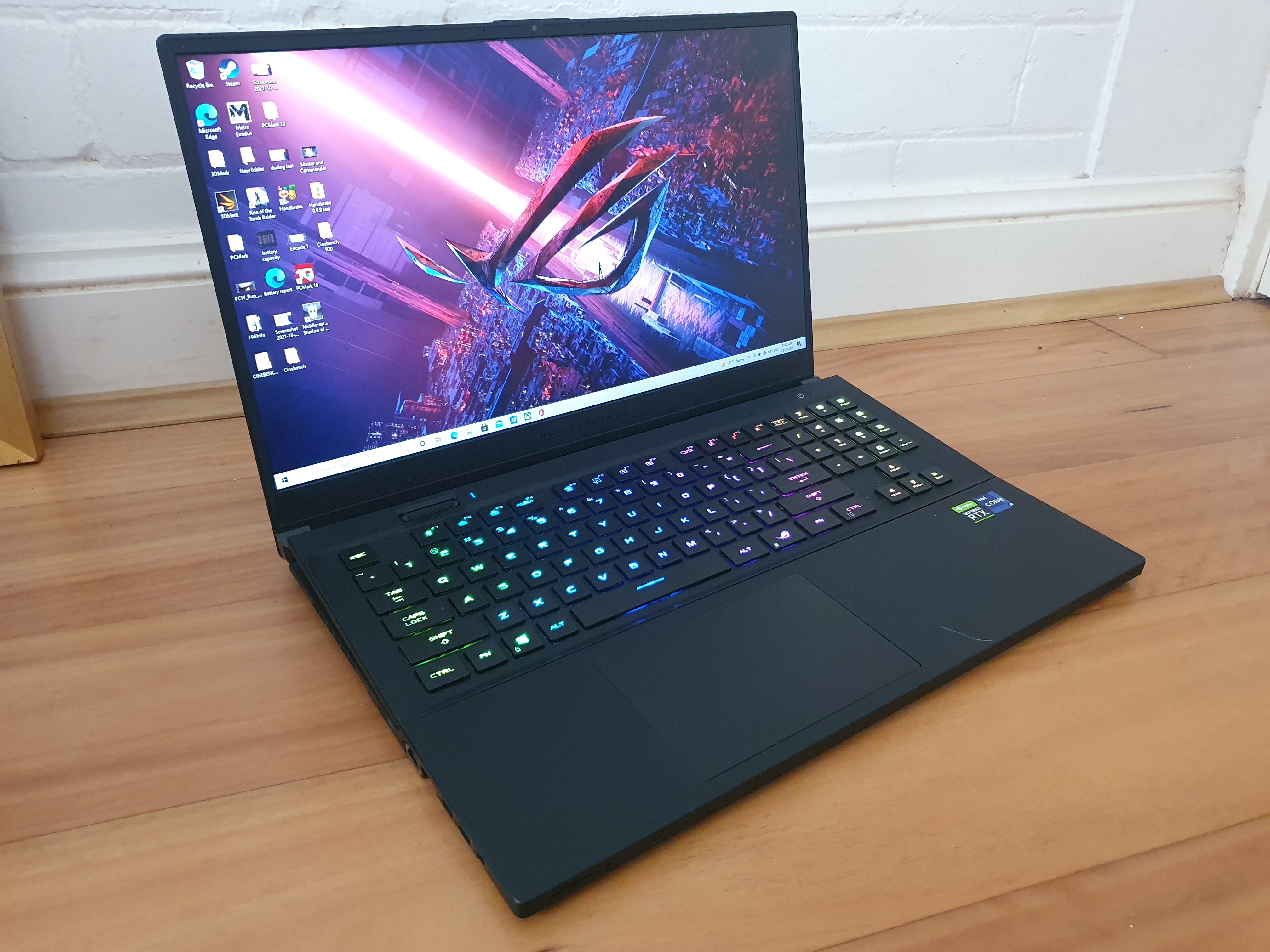
Pros
- Excellent CPU and GPU performance
- Robust and innovative design
- Comfortable and customizable keyboard
Cons
- Trackpad requires some pressure
- Very high price
MSRP:
$2,200 (base unit) up to $3,700 (review unit)
The Asus ROG Zephyrus S17 is a video editor’s ultimate dream. This laptop features lightning-fast GPU and CPU performance plus a stunning 17.3-inch 4K display with a 120Hz refresh rate. The rugged all-metal chassis, six speaker sound system, and customizable keyboard really adds to the premium experience as well. Better yet for video editors, it also includes an SD card slot and Thunderbolt ports galore. However, you’re going to pay out the nose for it. If you’ve got a flexible budget and you won’t settle for anything other than the best of the best, the Zephyrus S17 is truly the bees knees.
Read our full
Review Asus ROG Zephyrus S17
9. XPG Xenia 15 KC – Powerful portability, with minor caveats

Pros
- Very light
- Very quiet
- (relatively) very fast
Cons
- Subpar RGB
- Just barely adequate audio
- SD card reader barely adequate
When it comes to powerful laptops, many, if not most, of them are pretty bulky and heavy, often tipping the scales at five or six pounds. Well, that’s not the case with the XPG Xenia 15 KC. It weighs a little over four pounds, which is fairly lightweight for a laptop that’s capable of delivering zippy performance across the board. Plus, it runs very quiet. According to our review, it “rarely makes noise under normal use.” That’s impressive, as most gaming laptops tend to sound like a rocket blasting off. If you’re looking for something that’s both quiet and portable, the Xenia 15 KC is an excellent choice, though its 1440p display and relatively slow SD card reader performance may make some content creators balk.
Read our full
Review XPG Xenia 15 KC
What to look for in a laptop for video editing
The most important thing to look for in a laptop for video editing is its CPU and GPU. The faster your hardware, the faster your edits, essentially. In addition to subjecting all of the laptops above to our usual battery of benchmarks, we also ran the UL Procyon Video Editing Test on several high-powered laptops to see which hardware performs best for this sort of work. The benchmark tasks Adobe Premiere with importing two different video projects, applying visual effects such as color grading and transitions, and then exporting it using H.264, H.265 at both 1080p and 4K.
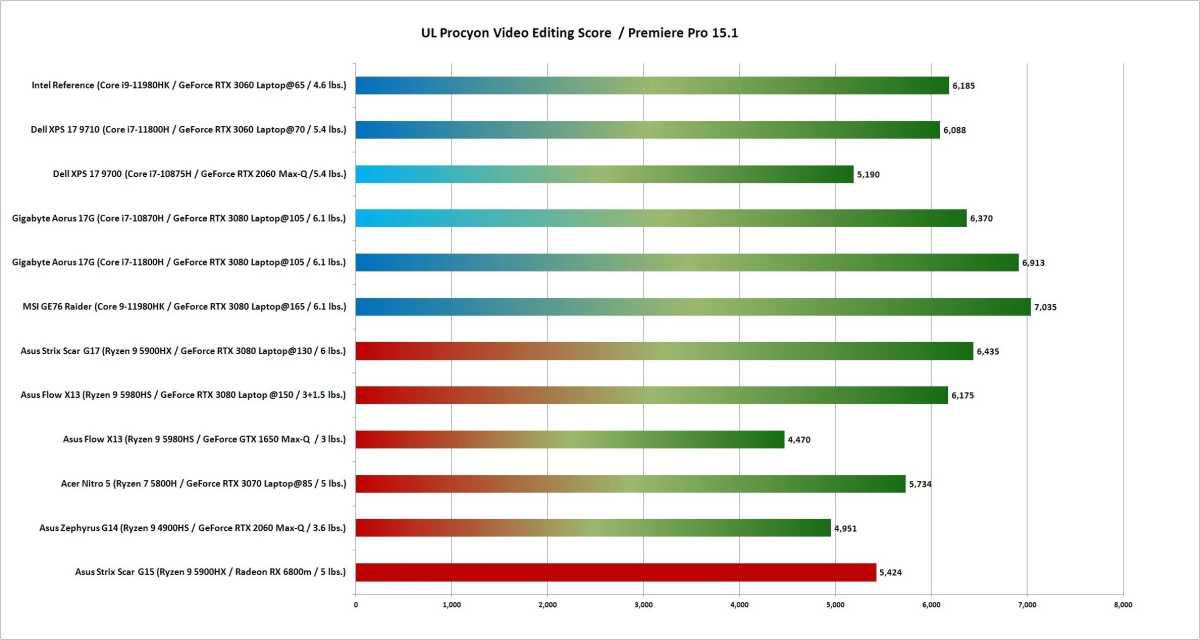
Right-click and select “open in new tab” to see in full resolution.
Gordon Mah Ung / IDG
The best performance came from big, heavy laptops running Intel’s 11th-generation processors, though notebooks with AMD’s beefy Ryzen 9 processors came in just behind, with 10th-gen Intel chips still putting up a respectable score. They’re not in the chart above, but newer Intel 12th-gen laptops run even faster still. The best-performing laptops all paired modern Intel CPUs with Nvidia’s RTX 30-series GPUs, which isn’t surprising as both companies have invested a lot of time and resources into optimizing their Adobe performance.
The GPU matters more than CPU in Premiere Pro, though things reach a point of diminishing returns very quickly. Notebooks wielding top-tier RTX 3080 graphics are indeed faster at video editing than laptops with more modest RTX 3060 graphics, but not by that much. If you look at the scores from the Dell XPS 17 9710, its GeForce RTX 3060 Laptop GPU is maybe 14 percent slower than the fastest RTX 3080 in the MSI GE76 Raider. That’s not a lot, especially when you consider how big and thick the GE76 Raider is compared to the Dell laptop.
In general, having any sort of discrete graphics is preferred, with at least an RTX 3060 recommended for serious video editing.
Video editing is very workflow dependent however. Your particular task and tool might be more CPU intensive, or lean more on the GPU than Premiere. If so, adjust your priorities accordingly. The selections above should all be great well-rounded options, however. Intel and Nvidia have spent years building up tools like Quick Sync and CUDA, respectively, and many video editing apps can see significant speed boosts because of it. AMD hardware does fine for video editing, but we recommend sticking to Intel and Nvidia unless you have a strong reason otherwise, especially if your workflow relies on their vendor-specific software optimizations.
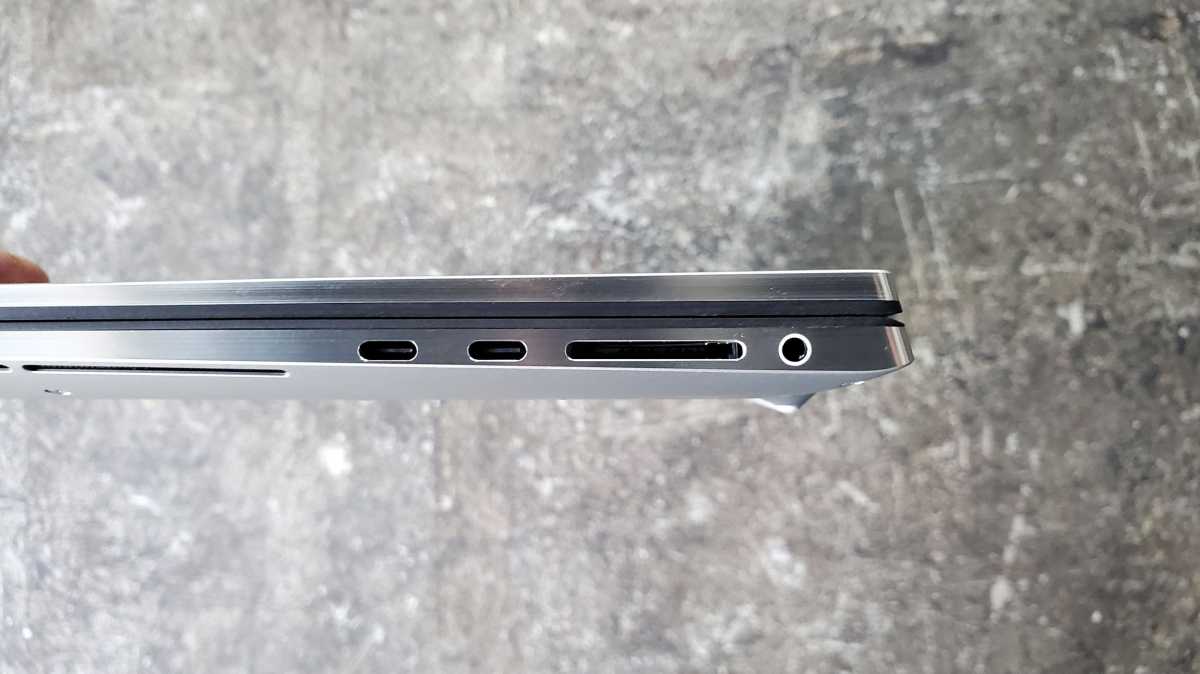
If you’re transferring video from a camera, an SD card port (like this one on the Dell XPS 17) is essential, unless you’re comfortable plugging an SD card adapter into a high-speed USB or Thunderbolt port.
Gordon Mah Ung/IDG
It’s not all about the internals though. PCWorld video director Adam Patrick Murray stresses that an ideal laptop for video editing includes an SD card reader for grabbing video off a camera. He also recommends opting for a notebook with a 4K, 60Hz panel over the ultra-fast 1080p panels often found on gaming laptops that would otherwise be ideal for video editing. You need a 4K panel to edit 4K videos well, and blazing-fast refresh rates don’t mean anything for video editing like they do for gaming. If color accuracy matters to you—it might not if you’re only creating casual videos for your personal YouTube channel, for example—then support for the full DCI-P3 color gamut is also a must, along with Delta E < 2 color accuracy.
You won’t often find those sorts of specs listed for (or supported by) gaming laptops, but dedicated content creation laptops should include that information. That said, if you want the fastest possible laptop for video editing that can also satisfy your gaming proclivities, you can always pair that burly gaming laptop with a color-accurate external monitor for creation tasks.
If you’re looking for a more general purpose notebook, be sure to check out our guide to the best laptops for picks for every budget. You may also find solid laptops for video editing for cheap in our roundup of the best laptop deals, which we update daily with the latest sales.
For all the latest Technology News Click Here
For the latest news and updates, follow us on Google News.
